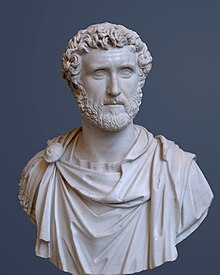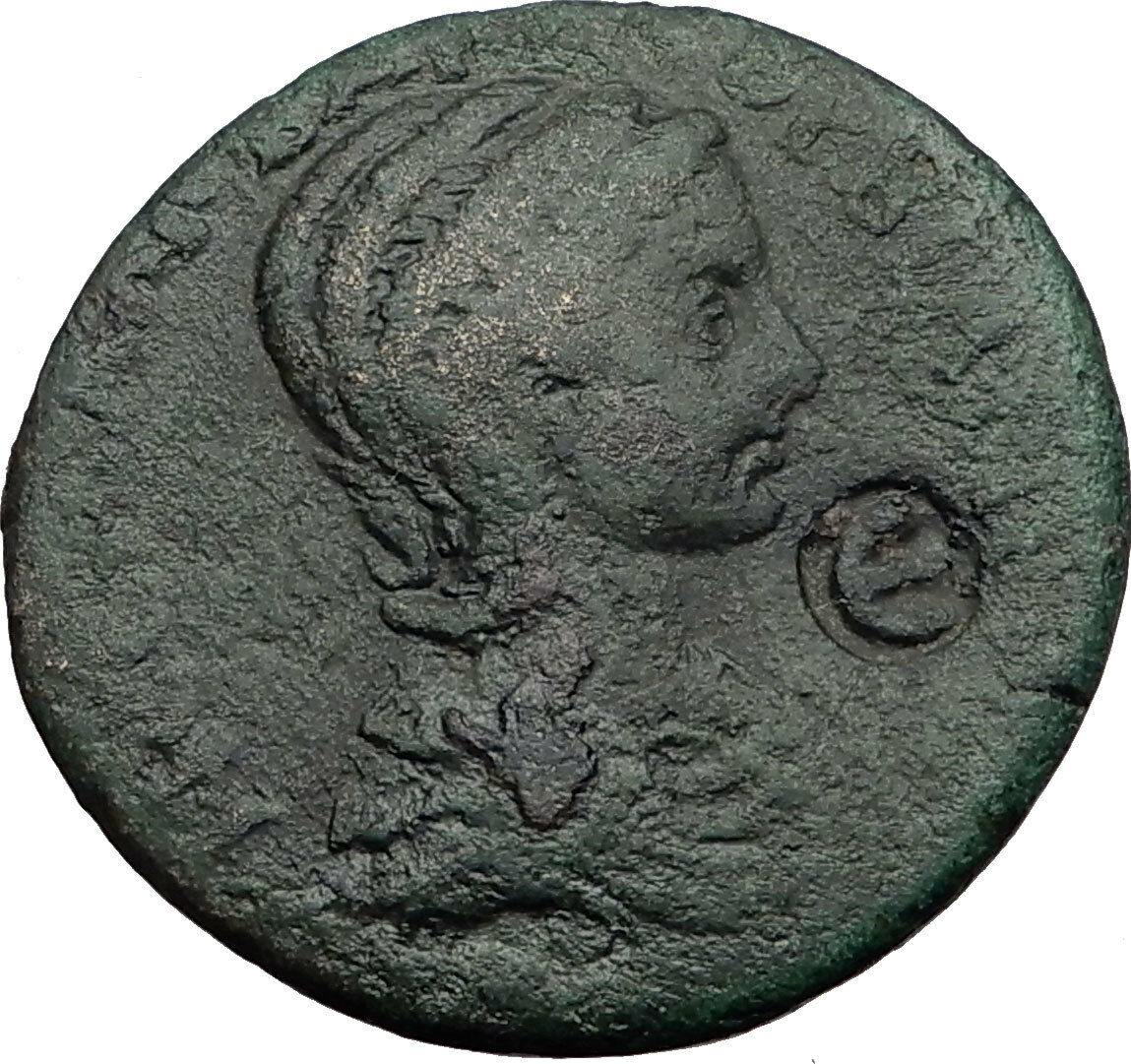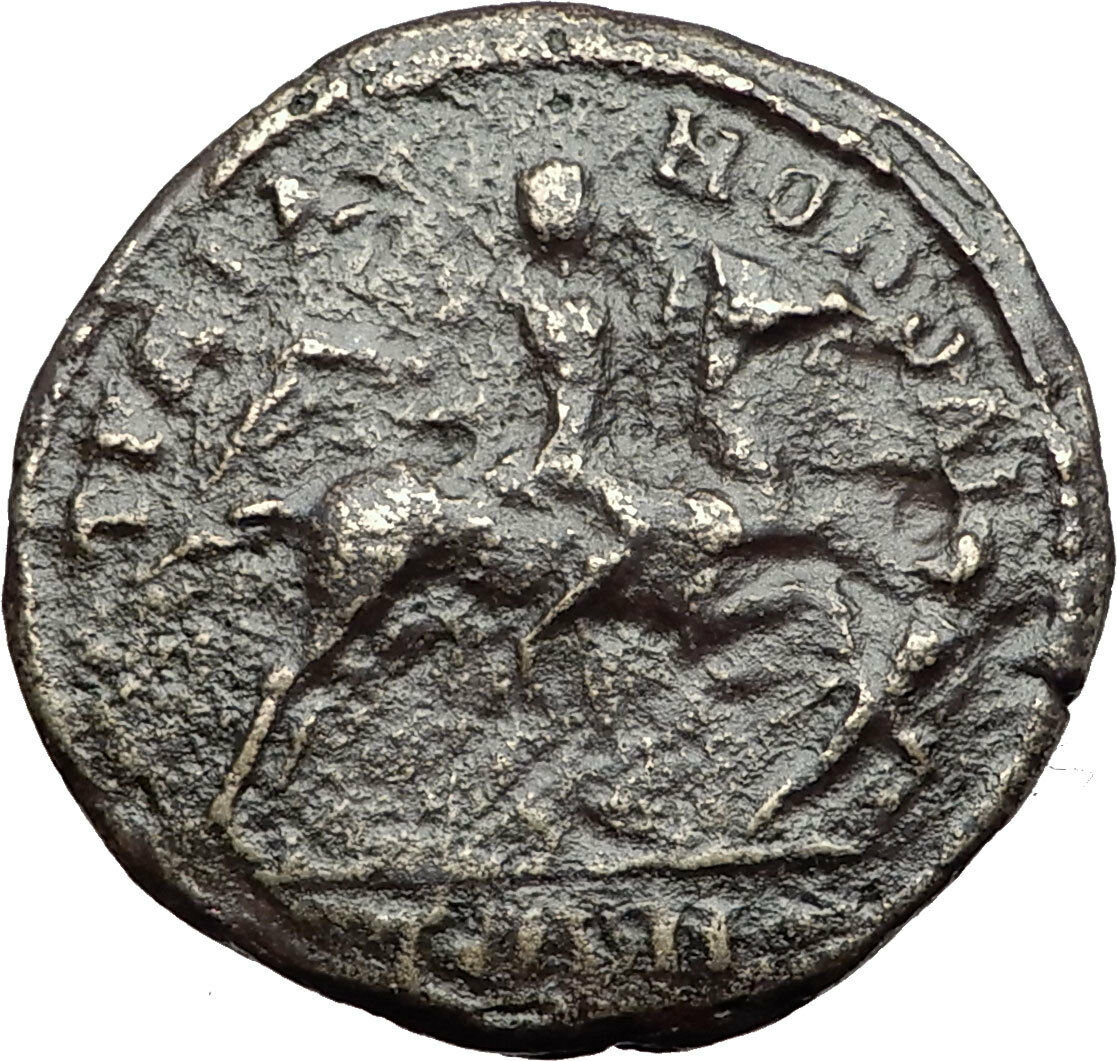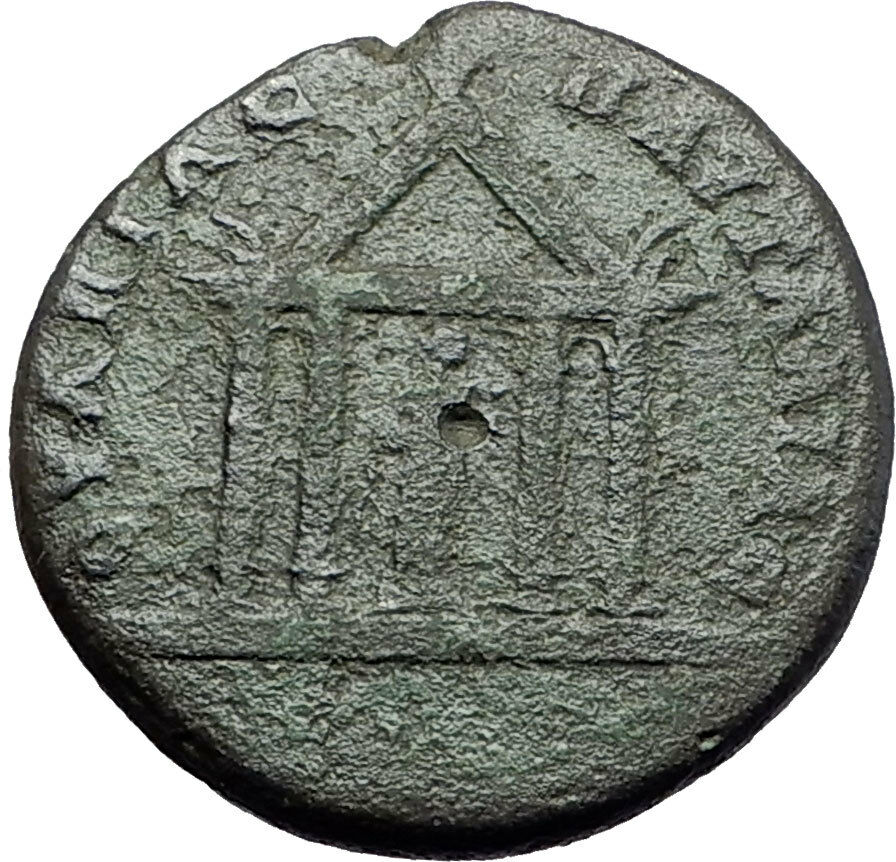|
Antoninus Pius
–
Roman Emperor
: 138-161 A.D.
Father of Marcus Aurelius
Bronze 20mm (4.33 grams) Struck in the Provincial mint of 138-161 A.D.
Laureate head right.
Asclepius standing facing, head left, leaning on
serpent-entwined (medical symbol) staff.
You are bidding on the exact
item pictured, provided with a Certificate of Authenticity and Lifetime
Guarantee of Authenticity.
![Asclepius with his serpent-entwined staff[1]](https://upload.wikimedia.org/wikipedia/commons/thumb/9/97/Statue_of_Asklepios_NAMA_263_(DerHexer).JPG/200px-Statue_of_Asklepios_NAMA_263_(DerHexer).JPG)
 Asclepius Asclepius
is the god of medicine
and healing in ancient
Greek religion
. Asclepius represents the
healing aspect of the medical arts; his daughters are
Hygieia
(“Health”),
Iaso (“Medicine”),
Aceso
(“Healing”),
Aglæa/Ægle
(“Healthy Glow”), and
Panacea
(“Universal Remedy”). The
rod of Asclepius
, a snake-entwined staff,
remains a symbol of medicine today, although sometimes the
caduceus
, or staff with two snakes, is
mistakenly used instead. He was associated with the Roman/Etruscan god
Vediovis
. He was one of
Apollo
‘s servants.

The
rod of Asclepius, also known as the asklepian, is an ancient
symbol associated with
astrology
, the
Greek
god
Asclepius
and with
medicine
and
healing
. It consists of a
serpent
entwined around a
staff
. The name of the symbol derives from its
early and widespread association with
Asclepius
, the son of
Apollo
, who was a practitioner of medicine in
ancient
Greek mythology
. His attributes, the snake and
the staff, sometimes depicted separately in antiquity, are combined in this
symbol. The Rod of Asclepius also represents the constellation
Ophiuchus
(or Ophiuchus Serpentarius), the
thirteenth sign of the
sidereal zodiac
.
Hippocrates
himself was a worshipper of
Asclepius.
Serpents and snakes play a role in many of the world’s myths and legends.
Sometimes these mythic beasts appear as ordinary snakes. At other times, they
take on magical or monstrous forms. Serpents and snakes have long been
associated with good as well as with evil, representing both life and death,
creation and destruction.
Serpents and Snakes as Symbols. In religion, mythology, and
literature, serpents and snakes often stand for fertility or a creative life
force—partly because the creatures can be seen as symbols of the male sex organ.
They have also been associated with water and earth because many kinds of snakes
live in the water or in holes in the ground. The ancient Chinese connected
serpents with life-giving rain. Traditional beliefs in Australia, India, North
America, and Africa have linked snakes with rainbows, which in turn are often
related to rain and fertility.
As snakes grow, many of them shed their skin at various times, revealing a
shiny new skin underneath. For this reason snakes have become symbols of
rebirth, transformation, immortality, and healing. The ancient Greeks
considered snakes sacred to Asclepius, the god of medicine. He carried a
caduceus, a staff with one or two serpents wrapped around it, which has become
the symbol of modern physicians.
For both the Greeks and the Egyptians, the snake represented eternity.
Ouroboros, the Greek symbol of eternity, consisted of a snake curled into a
circle or hoop, biting its own tail. The Ouroboros grew out of the belief that
serpents eat themselves and are reborn from themselves in an endless cycle of
destruction and creation.
Serpents figured prominently in archaic Greek myths. According to some
sources,
Ophion (“serpent”, a.k.a. Ophioneus), ruled the world with Eurynome
before the two of them were cast down by Cronus and Rhea. The oracles of the
Ancient Greeks were said to have been the continuation of the tradition begun
with the worship of the Egyptian cobra goddess,
Wadjet.
The
Minoan
Snake
Goddess brandished a serpent in either hand, perhaps evoking her role
as source of wisdom, rather than her role as Mistress of the Animals (Potnia
theron), with a leopard
under each arm. She is a Minoan version
of the Canaanite
fertility goddess
Asherah.
It is not by accident that later the infant
Heracles,
a liminal hero on the threshold between the old ways and the new Olympian world,
also brandished the two serpents that “threatened” him in his cradle. Classical
Greeks did not perceive that the threat was merely the threat of wisdom. But the
gesture is the same as that of the Cretan goddess.
Typhon
the enemy of the Olympian gods is described as a vast grisly monster with a
hundred heads and a hundred serpents issuing from his thighs, who was conquered
and cast into Tartarus
by
Zeus,
or confined beneath volcanic regions, where he is the cause of eruptions. Typhon
is thus the chthonic figuration of volcanic forces. Amongst his children by
Echidna are Cerberus
(a monstrous three-headed dog with a
snake for a tail and a serpentine mane), the serpent tailed
Chimaera
, the serpent-like chthonic water beast
Lernaean Hydra and the hundred-headed serpentine dragon
Ladon.
Both the Lernaean Hydra and Ladon were slain by
Heracles.
Python
was the earth-dragon of
Delphi,
she always was represented in the vase-paintings and by sculptors as a serpent.
Pytho was the chthonic enemy of Apollo
, who slew her and remade her former home
his own oracle, the most famous in Classical Greece.
Amphisbaena a Greek word, from amphis, meaning “both ways”, and
bainein, meaning “to go”, also called the “Mother of Ants”, is a mythological,
ant-eating serpent with a head at each end. According to Greek mythology, the
mythological amphisbaena was spawned from the blood that dripped from
Medusa
the Gorgon‘s
head as
Perseus flew over the Libyan Desert with her head in his hand.
Medusa and the other Gorgons were vicious female monsters with sharp fangs
and hair of living, venomous snakes whose origins predate the written myths of
Greece and who were the protectors of the most ancient ritual secrets. The
Gorgons wore a belt of two intertwined serpents in the same configuration of the
caduceus.
The Gorgon was placed at the highest point and central of the relief on the
Parthenon.
Asclepius, the son of Apollo and Koronis, learned the secrets of
keeping death at bay after observing one serpent bringing another (which
Asclepius himself had fatally wounded) healing herbs. To prevent the entire
human race from becoming immortal under Asclepius’s care, Zeus killed him with a
bolt of lightning. Asclepius’ death at the hands of Zeus illustrates man’s
inability to challenge the natural order that separates mortal men from the
gods. In honor of Asclepius, snakes were often used in healing rituals.
Non-poisonous snakes were left to crawl on the floor in dormitories where the
sick and injured slept. In
The Library
,
Apollodorus claimed that
Athena
gave Asclepius a vial of blood from the Gorgons. Gorgon blood had magical
properties: if taken from the left side of the Gorgon, it was a fatal poison;
from the right side, the blood was capable of bringing the dead back to life.
However
Euripides wrote in his tragedy
Ion
that the Athenian queen Creusa had
inherited this vial from her ancestor Erichthonios, who was a snake himself and
receiving the vial from Athena. In this version the blood of Medusa had the
healing power while the lethal poison originated from Medusa’s serpents.
Laocoön
was allegedly a priest of Poseidon
(or of Apollo, by some accounts) at
Troy;
he was famous for warning the Trojans in vain against accepting the Trojan Horse
from the Greeks, and for his subsequent divine execution. Poseidon (some say
Athena),
who was supporting the Greeks, subsequently sent sea-serpents to strangle
Laocoön and his two sons, Antiphantes and Thymbraeus. Another tradition states
that Apollo sent the serpents for an unrelated offense, and only unlucky timing
caused the Trojans to misinterpret them as punishment for striking the Horse.
Olympias, the mother of
Alexander the Great
and a princess of the
primitive land of
Epirus
, had the reputation of a snake-handler,
and it was in serpent form that Zeus was said to have fathered Alexander upon
her; tame snakes were still to be found at Macedonian
Pella
in the 2nd century AD (Lucian,
Alexander the false prophet
) and at
Ostia
a bas-relief shows paired coiled serpents
flanking a dressed altar, symbols or embodiments of the
Lares
of the household, worthy of veneration (Veyne 1987 illus p 211).
Aeetes
, the king of
Colchis
and father of the sorceress Medea
, possessed the
Golden Fleece. He guarded it with a massive serpent that never slept.
Medea, who had fallen in love with Jason
of the
Argonauts,
enchanted it to sleep so Jason could seize the Fleece.
Titus Aurelius Fulvus Boionius Arrius Antoninus (19 September 86 – 7
March 161), generally known in English as Antoninus Pius was
Roman emperor
from 138 to 161. He was the fourth of the
Five Good Emperors

Antoninus Pius
, Marcus Aurelius’
adoptive father and predecessor as emperor (Glyptothek).
and a member of the
Aurelii
. He
did not possess the
sobriquet
“Pius” until after
his accession to the throne. Almost certainly, he earned the name “Pius” because
he compelled the
Senate
to deify his adoptive father
Hadrian
; the
Historia Augusta
, however, suggests that he may have earned the name by
saving senators sentenced to death by Hadrian in his later years.
//
He was the son and only child of
Titus Aurelius Fulvus
,
consul
in 89
whose family came from
Nemausus
(modern Nîmes
)
and was born near
Lanuvium
and his mother was Arria Fadilla. Antoninus’ father and paternal grandfather
died when he was young and he was raised by
Gnaeus Arrius Antoninus
, his maternal grandfather, a man of integrity and
culture and a friend of
Pliny the Younger
. His mother married to Publius Julius Lupus (a man of
consular rank),
Suffect
Consul
in 98, and bore him a daughter called Julia Fadilla.
As a private citizen between 110 and 115, he married Annia Galeria
Faustina the Elder
. They had a very happy marriage. She was the daughter of
consul
Marcus Annius Verus
and
Rupilia
Faustina (a half-sister to Roman Empress
Vibia
Sabina
). Faustina was a beautiful woman, renowned for her wisdom. She spent
her whole life caring for the poor and assisting the most disadvantaged Romans.
Having filled with more than usual success the offices of
quaestor
and praetor
,
he obtained the consulship in 120; he was next appointed by the Emperor
Hadrian
as
one of the four
proconsuls
to administer
Italia
, then greatly increased his reputation by his conduct as
proconsul
of
Asia
. He acquired much favor with the Emperor Hadrian, who adopted him as
his son and successor on 25 February, 138, after the death of his first adopted
son Lucius Aelius
, on the condition that Antoninus would in turn adopt Marcus
Annius Verus, the son of his wife’s brother, and Lucius, son of Aelius Verus,
who afterwards became the emperors
Marcus Aurelius
and
Lucius
Verus
(colleague of Marcus Aurelius).
Emperor
On his accession, Antoninus’ name became “Imperator Caesar Titus Aelius
Hadrianus Antoninus Augustus Pontifex Maximus”. One of his first acts as Emperor
was to persuade the
Senate
to grant divine honours to Hadrian, which they had at first refused; his efforts
to persuade the Senate to grant these honours is the most likely reason given
for his title of Pius (dutiful in affection; compare
pietas
). Two other reasons for this title are that he would support his
aged father-in-law with his hand at Senate meetings, and that he had saved those
men that Hadrian, during his period of ill-health, had condemned to death. He
built temples, theaters, and mausoleums, promoted the arts and sciences, and
bestowed honours and financial rewards upon the teachers of
rhetoric
and philosophy
.
In marked contrast to his predecessors
Trajan
and
Hadrian
,
Antoninus was not a military man. One modern scholar has written “It is almost
certain not only that at no time in his life did he ever see, let alone command,
a Roman army, but that, throughout the twenty-three years of his reign, he never
went within five hundred miles of a legion”.[2]
His reign was the most peaceful in the entire history of the
Principate
;
while there were several military disturbances throughout the Empire in his
time, in Mauretania
,
Iudaea
, and amongst the
Brigantes
in Britannia
, none of them are considered serious. The unrest in Britannia is
believed to have led to the construction of the
Antonine Wall
from the
Firth of Forth
to the
Firth of Clyde
, although it was soon abandoned. He was virtually unique
among emperors in that he dealt with these crises without leaving Italy once
during his reign, but instead dealt with provincial matters of war and peace
through their governors or through imperial letters to the cities such as
Ephesus (of which some were publicly displayed). This style of government was
highly praised by his contemporaries and by later generations.
Of the public transactions of this period we have scant information, but, to
judge by what we possess, those twenty-two years were not remarkably eventful in
comparison to those before and after his; the surviving evidence is not complete
enough to determine whether we should interpret, with older scholars, that he
wisely curtailed the activities of the Roman Empire to a careful minimum, or
perhaps that he was uninterested in events away from Rome and
Italy
and his
inaction contributed to the pressing troubles that faced not only Marcus
Aurelius but also the emperors of the third century. German historian Ernst
Kornemann has had it in his Römische Geschichte [2 vols., ed. by H. Bengtson,
Stuttgart 1954] that the reign of Antoninus comprised “a succession of grossly
wasted opportunities,” given the upheavals that were to come. There is more to
this argument, given that the Parthians in the East were themselves soon to make
no small amount of mischief after Antoninus’ passing. Kornemann’s brief is that
Antoninus might have waged preventive wars to head off these outsiders.
Scholars place Antoninus Pius as the leading candidate for fulfilling the
role as a friend of Rabbi
Judah
the Prince
. According to the
Talmud
(Avodah
Zarah 10a-b), Rabbi Judah was very wealthy and greatly revered in Rome. He had a
close friendship with “Antoninus”, possibly Antoninus Pius,
who would consult Rabbi Judah on various worldly and spiritual matters.
After the longest reign since Augustus (surpassing
Tiberius
by
a couple of months), Antoninus died of fever at
Lorium
in
Etruria
,
about twelve miles (19 km) from Rome, on 7 March 161, giving the keynote to his
life in the last word that he uttered when the
tribune
of
the night-watch came to ask the password—”aequanimitas” (equanimity). His body
was placed in
Hadrian’s mausoleum
, a
column
was dedicated to him on the
Campus Martius
, and the
temple
he had built in the Forum in 141 to his deified wife Faustina was
rededicated to the deified Faustina and the deified Antoninus.
Historiography
The only account of his life handed down to us is that of the
Augustan History
, an unreliable and mostly fabricated work. Antoninus is
unique among Roman emperors in that he has no other biographies. Historians have
therefore turned to public records for what details we know.
In
later scholarship
Antoninus in many ways was the ideal of the landed gentleman praised not only
by ancient Romans, but also by later scholars of classical history, such as
Edward Gibbon
or the author of the article on Antoninus Pius in the ninth
edition of the
Encyclopedia Britannicaca:
A few months afterwards, on Hadrian’s death, he was enthusiastically
welcomed to the throne by the Roman people, who, for once, were not
disappointed in their anticipation of a happy reign. For Antoninus came
to his new office with simple tastes, kindly disposition, extensive
experience, a well-trained intelligence and the sincerest desire for the
welfare of his subjects. Instead of plundering to support his
prodigality, he emptied his private treasury to assist distressed
provinces and cities, and everywhere exercised rigid economy (hence the
nickname κυμινοπριστης “cummin-splitter”). Instead of exaggerating into
treason whatever was susceptible of unfavorable interpretation, he
spurned the very conspiracies that were formed against him into
opportunities for demonstrating his clemency. Instead of stirring up
persecution against the Christians, he extended to them the strong hand
of his protection throughout the empire. Rather than give occasion to
that oppression which he regarded as inseparable from an emperor’s
progress through his dominions, he was content to spend all the years of
his reign in Rome, or its neighborhood.
|





![Asclepius with his serpent-entwined staff[1]](https://upload.wikimedia.org/wikipedia/commons/thumb/9/97/Statue_of_Asklepios_NAMA_263_(DerHexer).JPG/200px-Statue_of_Asklepios_NAMA_263_(DerHexer).JPG)
 Asclepius
Asclepius 




